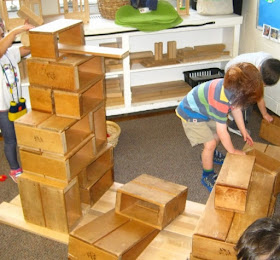An anecdote I frequently go back to happened many years
ago, in a school where teachers had been trained to “actively reflect” what the
children were doing, based on the idea that verbal narration would help
scaffold and extend their learning. One morning I watched a teacher sitting
with a four-year-old girl who was very intently building a wall across the
block area. As she slowly turned each block on its end, the teacher watched and
commented. “Oh, I see you’re balancing the square on top of the block.” The
child made a second row on top of the first. “I see you’re making another layer”,
the teacher said. Then, several blocks
fell over, and the teacher observed, “Some of the blocks are falling. What do
you think made that happen?”
The child turned to the teacher and said, “Teacher, you talk
way too much.”**
This situation, and many others like this, started me thinking
about how teachers speak to children while they play. Teaching in a play based
program changes the traditional role of the teacher. She isn’t there to provide
instruction or to directly present information. Her job is to structure the
environment, choose materials, observe, and to facilitate play. But I’ve always
struggled with exactly what “facilitate” means. On the one hand, in a play
based program, children are given the time and space for independent discovery.
On the other hand, teachers can provide information, suggestions, and
observations that might challenge the children, extend their thinking, or lead
them to reframe their explorations.
But there’s a third possibility. Sometimes we’re just
talking because we don't know how to not talk while teaching. The quiet, concentrated focus of
child-directed play can leave a vacuum of silence. And, even for teachers
trained to be facilitators rather than instructors, it’s hard to step away from
the baggage of the teacher role. Sitting and watching a child draw, or build
with blocks, or dig in the sand leaves us feeling like we should be “doing”
something. Especially when there’s a traditional academic objective to
reinforce. It’s hard for us to restrain ourselves from counting the blocks that
a child lined up, or commenting that their playdough looks like a letter “O”,
or repeating “yellow and blue make green” each time a child combines those two
colors of paint. But does the child really need to hear us say those words for
the learning to happen? Sometimes even open ended questions are more for our
benefit than for the child. “Tell me about what you’re making.” “What happened
when you mixed the colors together?” Our verbal narration and questioning of
their activities shifts the value from their doing to their describing.
If we truly believe that children learn through play, through self-directed
activity, and through the process of discovery, then we need to respect that
process, and allow children to be engaged in the flow of meaningful activity
without being interrupted by us.
That’s not to say that teachers shouldn’t speak, but our words should be meaningful, our questions genuine, and our comments presented with the intent of furthering the child’s activity, not simply narrating it. And sometimes, the best support we can give to a child is to simply be present. Today I sat next to a two-year-old who was drawing with markers. I held back the comments like “That’s a long red line around your whole paper” “I see you’re making lots of purple dots” or the vague “You’re working so hard on that picture.” I didn’t say anything, and just watched her work.
I’m pretty sure she already knew all about her red lines and
purple dots.
**from Michelle B, Patt & Artin Göncü, "Talking the Talk: Constructivist Teachers Guiding Children's Problem Solving", in Children in Play, Story, and School, Artin Göncü & Elisa L. Klein,
Eds., 2001.




















































